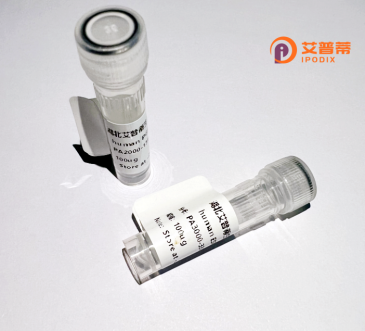
| 纯度 | >90%SDS-PAGE. |
| 种属 | Human |
| 靶点 | TRIM38 |
| Uniprot No | O00635 |
| 内毒素 | < 0.01EU/μg |
| 表达宿主 | E.coli |
| 表达区间 | 1-465 aa |
| 活性数据 | MASTTSTKKM MEEATCSICL SLMTNPVSIN CGHSYCHLCI TDFFKNPSQK QLRQETFCCP QCRAPFHMDS LRPNKQLGSL IEALKETDQE MSCEEHGEQF HLFCEDEGQL ICWRCERAPQ HKGHTTALVE DVCQGYKEKL QKAVTKLKQL EDRCTEQKLS TAMRITKWKE KVQIQRQKIR SDFKNLQCFL HEEEKSYLWR LEKEEQQTLS RLRDYEAGLG LKSNELKSHI LELEEKCQGS AQKLLQNVND TLSRSWAVKL ETSEAVSLEL HTMCNVSKLY FDVKKMLRSH QVSVTLDPDT AHHELILSED RRQVTRGYTQ ENQDTSSRRF TAFPCVLGCE GFTSGRRYFE VDVGEGTGWD LGVCMENVQR GTGMKQEPQS GFWTLRLCKK KGYVALTSPP TSLHLHEQPL LVGIFLDYEA GVVSFYNGNT GCHIFTFPKA SFSDTLRPYF QVYQYSPLFL PPPGD |
| 分子量 | 53.4 kDa |
| 蛋白标签 | His tag N-Terminus |
| 缓冲液 | PBS, pH7.4, containing 0.01% SKL, 1mM DTT, 5% Trehalose and Proclin300. |
| 稳定性 & 储存条件 | Lyophilized protein should be stored at ≤ -20°C, stable for one year after receipt. Reconstituted protein solution can be stored at 2-8°C for 2-7 days. Aliquots of reconstituted samples are stable at ≤ -20°C for 3 months. |
| 复溶 | Always centrifuge tubes before opening.Do not mix by vortex or pipetting. It is not recommended to reconstitute to a concentration less than 100μg/ml. Dissolve the lyophilized protein in distilled water. Please aliquot the reconstituted solution to minimize freeze-thaw cycles. |
以下是3篇关于TRIM38蛋白的研究文献概览:
1. **《TRIM38 inhibits TNFα- and IL-1β–triggered NF-κB activation by mediating lysosome-dependent degradation of TAB2/3》**
作者:Wang et al. (2017)
摘要:发现TRIM38通过促进TAB2/3蛋白的溶酶体降解,负调控NF-κB信号通路,从而抑制炎症因子TNFα和IL-1β诱导的过度免疫反应。
2. **《TRIM38 modulates the type I interferon response through targeting MITA for degradation》**
作者:Zhang et al. (2019)
摘要:揭示TRIM38通过K48连接的泛素化修饰促进MITA蛋白(参与DNA病毒感知的关键接头蛋白)的蛋白酶体降解,负反馈抑制抗病毒I型干扰素产生。
3. **《TRIM38 negatively regulates TLR3/4-mediated innate immune response by preventing TRIF auto-ubiquitination》**
作者:Zhao et al. (2016)
摘要:证明TRIM38通过阻断TLR3/4通路中TRIF接头蛋白的自泛素化,抑制下游IRF3和NF-κB活化,从而限制宿主针对RNA/DNA病毒的天然免疫应答强度。
TRIM38. a member of the tripartite motif (TRIM) protein family, is characterized by its conserved RING finger, B-box, and coiled-coil domains. Primarily involved in innate immunity, it modulates inflammatory and antiviral responses by regulating key signaling pathways, such as Toll-like receptor (TLR) and RIG-I-like receptor (RLR) cascades. As an E3 ubiquitin ligase, TRIM38 catalyzes ubiquitination—a post-translational modification critical for protein stability, localization, and activity. For instance, it stabilizes signaling components like TAB2/3 to promote TLR3/4-mediated cytokine production while destabilizing others, such as cGAS, to fine-tune DNA-sensing pathways and prevent excessive inflammation.
TRIM38 also interacts with TRAF proteins and IKK complexes, influencing NF-κB activation. Its role extends to antiviral defense by targeting viral proteins for degradation or restricting viral replication via interferon (IFN) regulation. Paradoxically, TRIM38 can exhibit pro- or anti-inflammatory effects depending on cellular context and stimuli. Dysregulation of TRIM38 is implicated in autoimmune diseases (e.g., lupus) and viral infections, highlighting its dual regulatory nature. Recent studies suggest its involvement in apoptosis and autophagy, further linking it to cancer and immune homeostasis. Though mechanistic details remain under investigation, TRIM38 exemplifies the complexity of immune regulation through ubiquitin-dependent pathways.
×